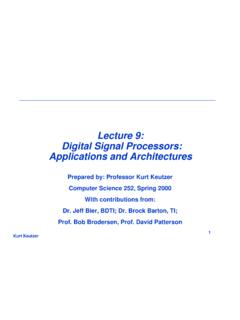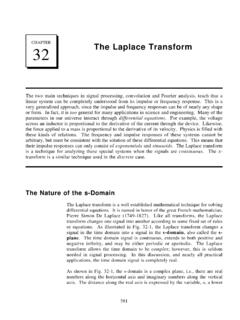Transcription of The Scientist and Engineer's Guide to Digital Signal ...
1 261 CHAPTER14 Introduction to Digital FiltersDigital filters are used for two general purposes: (1) separation of signals that have beencombined, and (2) restoration of signals that have been distorted in some way. Analog(electronic) filters can be used for these same tasks; however, Digital filters can achieve farsuperior results. The most popular Digital filters are described and compared in the next sevenchapters. This introductory chapter describes the parameters you want to look for when learningabout each of these filters. Filter BasicsDigital filters are a very important part of DSP.
2 In fact, their extraordinaryperformance is one of the key reasons that DSP has become so popular. Asmentioned in the introduction, filters have two uses: Signal separation andsignal restoration. Signal separation is needed when a Signal has beencontaminated with interference, noise, or other signals. For example, imaginea device for measuring the electrical activity of a baby's heart (EKG) whilestill in the womb. The raw Signal will likely be corrupted by the breathing andheartbeat of the mother. A filter might be used to separate these signals so thatthey can be individually analyzed.
3 Signal restoration is used when a Signal has been distorted in some way. Forexample, an audio recording made with poor equipment may be filtered tobetter represent the sound as it actually occurred. Another example is thedeblurring of an image acquired with an improperly focused lens, or a problems can be attacked with either analog or Digital filters. Whichis better? Analog filters are cheap, fast, and have a large dynamic range inboth amplitude and frequency. Digital filters, in comparison, are vastlysuperior in the level of performance that can be achieved. For example, alow-pass Digital filter presented in Chapter 16 has a gain of 1 +/- fromDC to 1000 hertz, and a gain of less than for frequencies aboveThe Scientist and Engineer's Guide to Digital Signal Processing2621001 hertz.
4 The entire transition occurs within only 1 hertz. Don't expectthis from an op amp circuit! Digital filters can achieve thousands of timesbetter performance than analog filters. This makes a dramatic difference inhow filtering problems are approached. With analog filters, the emphasisis on handling limitations of the electronics, such as the accuracy andstability of the resistors and capacitors. In comparison, Digital filters areso good that the performance of the filter is frequently ignored. Theemphasis shifts to the limitations of the signals, and the theoretical issuesregarding their processing . It is common in DSP to say that a filter's input and output signals are in thetime domain.
5 This is because signals are usually created by sampling atregular intervals of time. But this is not the only way sampling can take second most common way of sampling is at equal intervals in space. Forexample, imagine taking simultaneous readings from an array of strain sensorsmounted at one centimeter increments along the length of an aircraft wing. Many other domains are possible; however, time and space are by far the mostcommon. When you see the term time domain in DSP, remember that it mayactually refer to samples taken over time, or it may be a general reference toany domain that the samples are taken shown in Fig.
6 14-1, every linear filter has an impulse response, a stepresponse and a frequency response. Each of these responses containscomplete information about the filter, but in a different form. If one of thethree is specified, the other two are fixed and can be directly calculated. Allthree of these representations are important, because they describe how thefilter will react under different circumstances. The most straightforward way to implement a Digital filter is by convolving theinput Signal with the Digital filter's impulse response. All possible linear filterscan be made in this manner. (This should be obvious.)
7 If it isn't, you probablydon't have the background to understand this section on filter design. Tryreviewing the previous section on DSP fundamentals). When the impulseresponse is used in this way, filter designers give it a special name: the filterkernel. There is also another way to make Digital filters, called recursion. Whena filter is implemented by convolution, each sample in the output iscalculated by weighting the samples in the input, and adding them filters are an extension of this, using previously calculated valuesfrom the output, besides points from the input. Instead of using a filterkernel, recursive filters are defined by a set of recursion coefficients.
8 Thismethod will be discussed in detail in Chapter 19. For now, the importantpoint is that all linear filters have an impulse response, even if you don'tuse it to implement the filter. To find the impulse response of a recursivefilter, simply feed in an impulse, and see what comes out. The impulseresponses of recursive filters are composed of sinusoids that exponentiallydecay in amplitude. In principle, this makes their impulse responsesinfinitely long. However, the amplitude eventually drops below the round-offnoise of the system, and the remaining samples can be ignored. BecauseChapter 14- Introduction to Digital Frequency responseSample Impulse Step Frequency response (in dB)FIGURE 14-1 Filter parameters.
9 Every linear filter has an impulse response, a step response, and a frequency response. Thestep response, (b), can be found by discrete integration of the impulse response, (a). The frequency responsecan be found from the impulse response by using the Fast Fourier Transform (FFT), and can be displayed eitheron a linear scale, (c), or in decibels, (d).FFTI ntegrate20 Log( )AmplitudeAmplitudeAmplitude (dB)Amplitudeof this characteristic, recursive filters are also called Infinite ImpulseResponse or IIR filters. In comparison, filters carried out by convolution arecalled Finite Impulse Response or FIR filters. As you know, the impulse response is the output of a system when the input isan impulse.
10 In this same manner, the step response is the output when theinput is a step (also called an edge, and an edge response). Since the step isthe integral of the impulse, the step response is the integral of the impulseresponse. This provides two ways to find the step response: (1) feed a stepwaveform into the filter and see what comes out, or (2) integrate the impulseresponse. (To be mathematically correct: integration is used with continuoussignals, while discrete integration, , a running sum, is used with discretesignals). The frequency response can be found by taking the DFT (using theFFT algorithm) of the impulse response.












